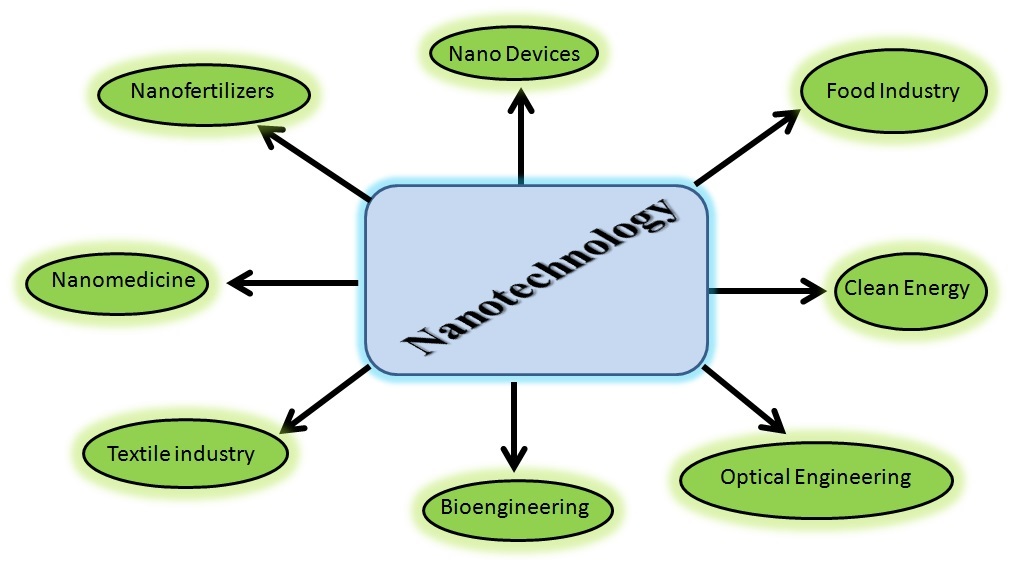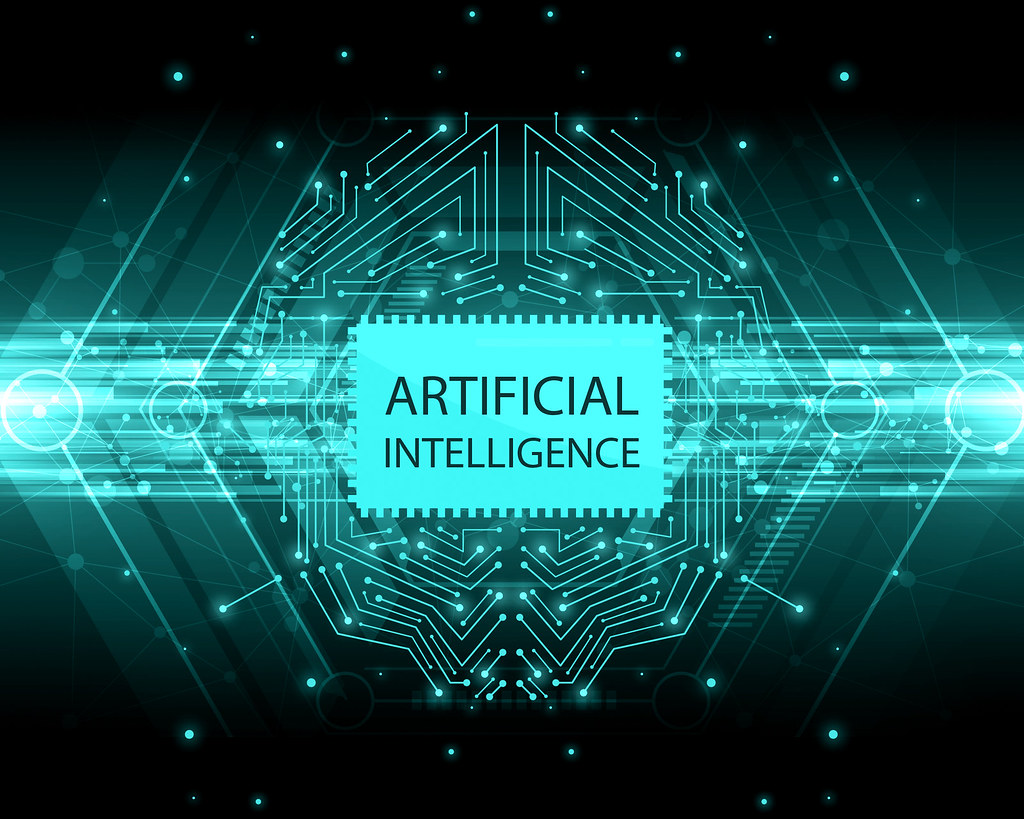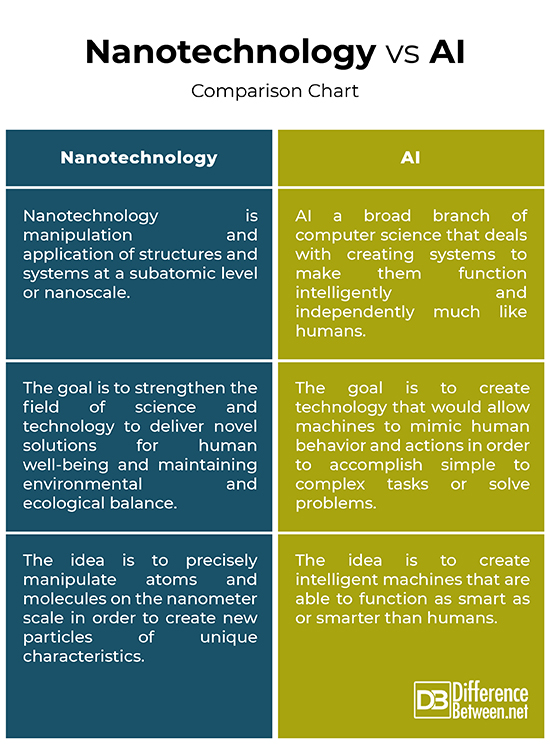Difference Between Nanotechnology and AI
Whether we believe it or not but we are surrounded by all kinds of fascinating yet revolutionary technologies that make our everyday lives so much better. Smartphone, for one, is one of the best things ever happened to humans. We cannot even get through a day without our precious smartphones or just any mobile device for that matter. Those virtual personal assistants on your smartphones you’re so used to are one of the biggest technological advancements on a mobile device. Well, that virtual personal assistant is artificial intelligence, or AI. AI is a revolutionary technology that intends to make machines smarter, intelligent and responsive. Then, we have nanotechnology, yet another major driving force behind the modern-day technological revolution.

What is Nanotechnology?
For the past few decades, scientists and engineers have done some extensive research on designing and engineering materials down at the level of atoms, or small groups of atoms. Because this technology is something that involves doing stuff at such a microscopic level, it is called nanotechnology. Nanotechnology is one of the hottest fields in science, business and news these days. The word ‘nano’ may be just a little word but it has got big potential and is rapidly insinuating into the world’s consciousness. When we say nano, we mean something it is very small. The size of a nanometer is one billionth of a meter which is about 100,000 times smaller than the width of a human hair. Making stuff at this incredibly small scale is nanotechnology. It involves development, manipulation and application of materials at a nanoscale. Nanotechnology can be potentially applied to a variety of applications including industrial and military applications.

What is Artificial Intelligence (AI)?
Artificial Intelligence, or simply referred to as ‘AI’, is based on a very powerful idea – to create intelligent machines, ones that are as smart as or smarter than humans. The idea of making machines smart is not new; in fact, people have been trying to make smarter machines for centuries but the idea has only become part of modern science with the rise of digital computers. The origin of AI can be traced back to small workshop in 1956 at Dartmouth College organized by a young mathematician named John McCarthy. So, what is AI? AI is the science of making machines smart, using algorithms to allow computers to accomplish tasks or solve problems. AI is a broad branch of computer science that is concerned with creating systems that can function intelligently and independently much like humans do. Because AI is intelligence demonstrated by machines, it is often called machine intelligence. AI is almost everywhere around us, from Siri to chatbots, e-commerce and self-driving cars.
Difference between Nanotechnology and AI
Definition
– Nanotechnology is manipulation and application of structures and systems at a subatomic level or nanoscale. Making stuff at an incredibly small scale is nanotechnology. It is a field of research and innovation that involves extremely small things and which can be applied across all other respective fields of science. AI, sometimes called machine intelligence, is the science of making machines smart, almost as smart as or smarter than humans. It is a broad branch of computer science that deals with creating systems, particularly computer systems, to make them function intelligently and independently much like humans do.
Goal
– The discipline of nanotechnology intends to strengthen the field of science and technology to deliver novel solutions for human well-being and maintaining environmental and ecological balance. The idea is to precisely manipulate atoms and molecules on the nanometer scale in order to exploit unique characteristics of such particles to create new particles of unique characteristics. The goal of AI is to create technology that would allow machines to mimic human behavior and actions in order to accomplish simple to complex tasks or solve problems. In short, the idea behind AI is to create intelligent machines that are able to function as smart as or smarter than humans.
Applications
– Nanotechnology is used in a wide range of applications such as drug delivery, bioinformatics, tissue engineering, manufacturing and construction, cosmetics, agriculture and food industry, healthcare, textile industry, energy sector, and more. Nanotechnology is also used in a range of everyday consumer products such as hand wash, bandage, sunscreen, etc. Common applications of AI include virtual assistants such as Siri, Cortana, Google Now, or chatbots. Other applications of AI include ecommerce, ridesharing apps, social networking apps, disease mapping, NLP tools, smart assistants, manufacturing robots, healthcare management, etc.
Nanotechnology vs. AI: Comparison Chart

Summary
There are some rapidly growing areas where the two fields converge. Well, AI and nanotech are not two contradictory technologies; in fact, the two technologies can be combined together and the merger can lead to wonders. Technically speaking, nanotechnology is a combined knowledge of physics, chemistry and engineering, whereas AI is a technological breakthrough and a key to making smarter machines. Well, nanotechnology could be the key to making machines smarter. AI simply feeds data into computer systems while using simple algorithms to emulate certain aspects of human intelligence in order to make smart business decisions or discover patterns for valuable insights.
- Difference Between Caucus and Primary - June 18, 2024
- Difference Between PPO and POS - May 30, 2024
- Difference Between RFID and NFC - May 28, 2024
Search DifferenceBetween.net :
Leave a Response
References :
[0]Gurtler, Volker et al. Nanotechnology. Massachusetts, United States: Academic Press, 2019. Print
[1]Ratner, Mark et al. Nanotechnology: A Gentle Introduction to the Next Big Idea. New Jersey, United States: Prentice Hall, 2003. Print
[2]Haugeland, John. Artificial Intelligence: The Very Idea. Massachusetts, United States: MIT Press, 1989. Print
[3]Mitchell, Melanie. Artificial Intelligence: A Guide for Thinking Humans. New York, United States: Macmillan Publishers, 2019. Print
[4]Image credit: https://live.staticflickr.com/1942/30188200627_c5ea2a3779_b.jpg
[5]Image credit: https://commons.wikimedia.org/wiki/File:Application_of_nanotechnology.jpg
